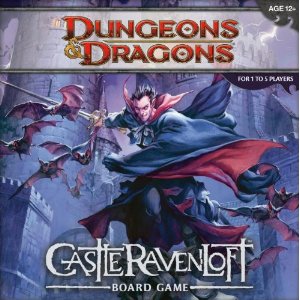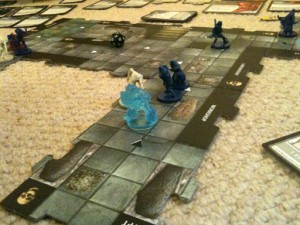Review: D&D: Castle Ravenloft
Posted by James (admin) on August 14th, 2011
 I have played many adventure-style board games over the years – some were simple fun like Heroquest and Space Crusade whereas some have had more meat to them with modular board sections like Claustrophobia and Space Hulk (the latter being a classic game in my opinion). So, I was very interested when Dungeons & Dragons: Castle Ravenloft was announced with modular board adventuring and receiving positive opinion.
I have played many adventure-style board games over the years – some were simple fun like Heroquest and Space Crusade whereas some have had more meat to them with modular board sections like Claustrophobia and Space Hulk (the latter being a classic game in my opinion). So, I was very interested when Dungeons & Dragons: Castle Ravenloft was announced with modular board adventuring and receiving positive opinion.
The game is co-operative with 1 to 5 players aiming to defeat the scenario they are playing. As you’d expect from D&D, players control heroes of different types each with their own unique abilities. Players get to choose their abilities (some unlimited use and some one-off) at the start of the game.
The combat system is very simple – roll a 20-sided dice (d20) and add on your combat bonus (based on which ability you’re using) then damage is caused if the total is equal to or greater than the target’s armour class (AC) . Most creatures are killed by any amount of damage but some take more. Heroes take damage too – a player on zero hit points (HP) is unconscious and, if still unconscious at the start of their next turn, must use one of heroes’ healing surges (they start an adventure with two). A healing surge gives some HP back but if the heroes have no more healing surges then the game is over and the heroes have lost.
Players take turns – first, they move and/or attack; then, if the hero is at the edge of a dungeon tile, they add a new random tile to the edge and spawn a monster on it. If they didn’t add a tile (and sometimes even if they did) an event card is drawn which is usually bad: heroes get attacked, traps get triggered, or on-going events will hinder the heroes. Finally, any monsters that were drawn by the current hero (in this or previous turns) activate which usually means they attack the nearest hero or move closer.
 It all sounds simple and fast-flowing (with monsters attacking at different points during a round rather than a single monster turn). However, the game’s simplicity delivers a very dry and repetitive experience. Each round, your hero attacks something (if possible), adds a new tile and then gets attacked by the monster on it. After a few rounds this gets very boring. Plus, you can’t plan ahead because most things have changed by your next turn and, as random monsters are added bit by bit, it means there can be no real planning or co-ordination. I’d have much preferred a game where the heroes really work together to combine their skills, storming rooms, sneaking past creatures, etc. Instead, the experience is more like an co-ordinated bundle like 5-year olds playing football (soccer) all chasing the ball at the same time rather than having any formation.
It all sounds simple and fast-flowing (with monsters attacking at different points during a round rather than a single monster turn). However, the game’s simplicity delivers a very dry and repetitive experience. Each round, your hero attacks something (if possible), adds a new tile and then gets attacked by the monster on it. After a few rounds this gets very boring. Plus, you can’t plan ahead because most things have changed by your next turn and, as random monsters are added bit by bit, it means there can be no real planning or co-ordination. I’d have much preferred a game where the heroes really work together to combine their skills, storming rooms, sneaking past creatures, etc. Instead, the experience is more like an co-ordinated bundle like 5-year olds playing football (soccer) all chasing the ball at the same time rather than having any formation.
The heroes lose when they need a healing surge and don’t have one. Failing the adventure because not everybody survived seems ridiculous – no tales of heroic sacrifice. I’m sure the rule is there to ensure players don’t die and get left out but there are better solutions to this and feels lazy.
Making things worse, the modular board system is boring – it’s very dull to look at and sometimes jigged ends with corridor are interwoven with jigged ends that are plain black wall which look messy. However, the main problem is that all the tiles are so similar that they don’t make any real gameplay difference and deliver a large amorphous area. Also, the rules system diminishes the importance of the exact location of heroes on squares as most monsters move to the nearest hero on the next tile regardless of exact square – it would have been better to do away with the squares on the tiles, allow the players to move by tile (not by square) and this would allow each tile to be really varied in their look.
The game comes with 12 different scenarios which are relatively varied; however, the game system makes the experience of each very similar. The plastic figures are nicely sculpted, especially the giant undead dragon although, unfortunately, the hero figures are dark blue plastic so it’s very hard to see them clearly.
The monster cards are a bit repetitive – I know the monsters are limited by the figures in the box but at least make one skeleton different to another by its stats and/or abilities. The event cards have lots of variety, and there are plenty of them, which is good. However, the graphical design of all the cards is rather dull especially given all the artwork that Wizards of the Coast own that they could have used. Even making the backs of the cards more stylish would have been an improvement. For example, the healing surge markers have a very flat, greyish starburst design with the word ‘Healing Surge’ on one side and text about it on the other – not very thematic or imaginative.
I usually find something redeeming about most games but I struggled this time. I was really looking forwards to D&D Castle Ravenloft – instead, I found it to be a drab dungeon bash with little strategy, no engagement and no variety. Maybe it’s a good game for young players but there are plenty of other better dungeon adventure games to play. I’m not sure why it had such positive opinion – for me, it’s been boring and disappointing, especially given its cost, although I’m sure the game will sell because of the brand.
James.
[Played with 5 players and as a 1-player game using 1, 2 and 5 heroes]

